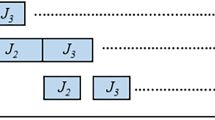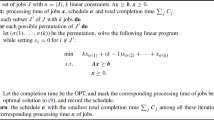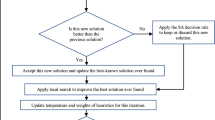Abstract
We consider the 1D skiving stock problem (SSP) which is strongly related to the dual bin packing problem: find the maximum number of products with minimum length L that can be constructed by connecting a given supply of \( m \in {\mathbb {N}} \) smaller item lengths \( l_1,\ldots ,l_m \) with availabilities \( b_1,\ldots , b_m \). For this NP-hard optimization problem, we focus on the proper relaxation and introduce a modeling approach based on graph theory. Additionally, we investigate the quality of the proper gap, i.e., the difference between the optimal objective values of the proper relaxation and the SSP itself. As an introductorily motivation, we prove that the SSP does not possess the integer round down property (IRDP) with respect to the proper relaxation. The main contribution of this paper is given by a construction principle for an infinite number of non-equivalent non-proper-IRDP instances and an enumerative approach that leads to the currently largest known (proper) gap.


Similar content being viewed by others
Notes
For further investigations and more detailed considerations, we refer the interested reader to the preprint Martinovic and Scheithauer (2015b).
The authors would like to thank A.Ripatti from the Bashkir State Pedagogical University (Russia) for valuable contributions regarding these computations. In particular, we would like to express our gratitude to him for sharing his pool of instances with large proper gaps with us, which represents an important basis for the computation of \( {\varDelta }^n(E) \) in Table 2.
References
Alvim ACF, Ribeiro CC, Glover F, Aloise DJ (2004) A hybrid improvement heuristic for the one-dimensional bin packing problem. J Heuristics 10(2):205–229
Assmann SF (1983) Problems in discrete applied mathematics. PhD thesis, Mathematics Department, Massachusetts Institute of Technology
Assmann SF, Johnson DS, Kleitman DJ, Leung JY-T (1984) On a dual version of the one-dimensional bin packing problem. J Algorithms 5:502–525
Baum S, Trotter LE (1981) Integer rounding for polymatroid and branching optimization problems. SIAM J Algebraic Discret Methods 2:416–425
Brandão F, Pedroso JP (2016) Bin packing and related problems: general arc-flow formulation with graph compression. Comput Oper Res 69:56–67
Bruno JL, Downey PJ (1985) Probabilistic bounds for dual bin-packing. Acta Inf 22:333–345
Chan LMA, Simchi-Levi D, Bramel J (1998) Worst-case analyses, linear programming and the bin-packing problem. Math Program 83(1–3):213–227
Csirik J, Frenk JBG, Galambos G, Rinnooy Kan AHG (1991) Probabilistic analysis of algorithms for dual bin packing problems. J Algorithms 12:189–203
de Carvalho Valério JM (2002) LP models for bin packing and cutting stock problems. Eur J Oper Res 141(2):253–273
Fieldhouse M (1990) The duality gap in trim problems. SICUP Bull 5:4–5
Gilmore PC, Gomory RE (1961) A linear programming approach to the cutting-stock problem (Part I). Oper Res 9:849–859
Johnson MP, Rennick C, Zak EJ (1997) Skiving addition to the cutting stock problem in the paper industry. SIAM Rev 39(3):472–483
Kantorovich LV (1939 Russian, 1960 English) Mathematical methods of organising and planning production. Manag Sci 6:366–422
Kartak VM, Ripatti AV, Scheithauer G, Kurz S (2015) Minimal proper non-IRUP instances of the one-dimensional cutting stock problem. Discret Appl Math 187:120–129
Labbé M, Laporte G, Martello S (1995) An exact algorithm for the dual bin packing problem. Oper Res Lett 17:9–18
Marcotte O (1986) An instance of the cutting stock problem for which the rounding property does not hold. Oper Res Lett 4(5):239–243
Martinovic J, Scheithauer G (2015a) Integer rounding and modified integer rounding for the skiving stock problem. Dresden University of Technology, Preprint MATH-NM-02-2015
Martinovic J, Scheithauer G (2015b) The proper relaxation and the proper gap of the skiving stock problem. Dresden University of Technology, Preprint MATH-NM-04-2015
Martinovic J, Scheithauer G (2016a) LP-based relaxations of the skiving stock problem—improved upper bounds for the gap. Proceedings of the Operations Research Conference 2015, Wien 2015 (to appear)
Martinovic J, Scheithauer G (2016b) Integer linear programming models for the skiving stock problem. Eur J Oper Res 251(2):356–368
Martinovic J, Jorswieck E, Scheithauer G (2016c) The skiving stock problem and its application to cognitive radio networks. In: Proceedings of the 8th IFAC conference on modelling, management and control (to appear)
Nitsche C, Scheithauer G, Terno J (1999) Tighter relaxations for the cutting stock problem. Eur J Oper Res 112(3):654–663
Peeters M, Degraeve Z (2006) Branch-and-price algorithms for the dual bin packing and maximum cardinality bin packing problem. Eur J Oper Res 170(2):416–439
Rietz J, Scheithauer G (2002) Families of non-IRUP instances of the one-dimensional cutting stock problem. Discret Appl Math 121:229–245
Scheithauer G (2008) Zuschnitt- und Packungsoptimierung—Problemstellungen, Modellierungstechniken, Lösungsmethoden, 1st edn. Vieweg+Teubner, Wiesbaden
Tragos EZ, Zeadally S, Fragkiadakis AG, Siris VA (2013) Spectrum assignment in cognitive radio networks: a comprehensive survey. IEEE Commun Surv Tutor 15(3):1108–1135
Vijayakumar B, Parikh P, Scott R, Barnes A, Gallimore J (2013) A dual bin-packing approach to scheduling surgical cases at a publicly-funded hospital. Eur J Oper Res 224(3):583–591
Wolsey LA (1977) Valid inequalities, covering problems and discrete dynamic programs. Ann Discret Math 1:527–538
Zak EJ (2003) The skiving stock problem as a counterpart of the cutting stock problem. Int Trans Oper Res 10:637–650
Author information
Authors and Affiliations
Corresponding author
Rights and permissions
About this article
Cite this article
Martinovic, J., Scheithauer, G. The proper relaxation and the proper gap of the skiving stock problem. Math Meth Oper Res 84, 527–548 (2016). https://doi.org/10.1007/s00186-016-0552-2
Received:
Accepted:
Published:
Issue Date:
DOI: https://doi.org/10.1007/s00186-016-0552-2




